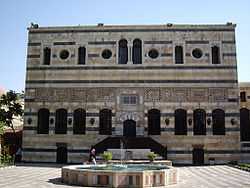Al-Azm family
| Al-Azm Family آل العظم | |
|---|---|
|
Azm Palace in Damascus | |
| Ethnicity | Primarily Syrian of Arab descent |
| Current region | Damascus, Hama |
| Place of origin |
|
| Notable members |
Sulayman Pasha al-Azm As'ad Pasha al-Azm Sa'deddin Pasha al-Azm Abdullah Pasha al-Azm Haqqi al-Azm Khalid al-Azm Sadiq Jalal al-Azm |
| Connected families | Muayyad al-Azm |
| Estate |
Azm Palace (nationalized) Azm Palace (Hama) (nationalized) |
Al-Azm family (Arabic: آل العظم) is a prominent Damascene family. The origins of the family are Arabic, as it belonged to a notable family from the region of Ma'arrat al-Numan south of Aleppo. The family rose to prominence in the 18th century. Their rule started with appointment of Ismail Pasha al-Azm as wāli of Damascus in 1725. Between 1725 and 1783, members of the family, including the famous As'ad Pasha al-Azm, held power in Damascus for 47 years, in addition to periodical appointments in Sidon, Tripoli, Hama, and Aleppo.[1] The family's influence declined in the 19th century, failing to establish a true dynasty.[2]
History
The origins of the al-Azm family are relatively obscure.[3] They likely originated from the region of Konya in Anatolia and were considered Awlad al-Arab or descendants of an Arab tribe, making them one of the few Arab aghawat ("military") families in Ottoman Syria.[4] They began to emerge as a major influence in the region in the early 18th-century from the their stronghold in the fortress of Maarrat al-Nu'man.[3] From 1717, Ismail Pasha al-Azm, the commander of the fortress and son of a professional soldier, became governor of Homs and Hama for seven years. The latter city would become a long-time stronghold of the family.[5]
Ismail Pasha, who later became wāli (governor) of Tripoli, was transferred to Damascus in 1725 at the request of the mufti, after fighting between different factions of janissaries prevented the Hajj caravan from departing on time. His brother became the wali of Tripoli, and his son became the wali of Sidon. In 1730 when Ahmed III was deposed they were all dismissed, but not for long. Sulayman Pasha al-Azm, brother of Ismail Pasha, became wali of Damascus between 1733 and 1738 and again from 1741 until his death in 1743. He was succeeded by his nephew As'ad Pasha al-Azm who reigned between 1743 and 1757, and was considered the greatest governor of Damascus in Ottoman times. As'ad Pasha overcame all his local adversaries after three years struggle. In his reign Hama and Homs were added to the province of Damascus.[6]
Despite As'ad Pasha's ability to ensure the security of the pilgrim caravan, the new Ottoman authorities in Istanbul deposed him in 1757 after fourteen years of governance. The Grand Vizier at the time, Raghib Pasha, denounced him as a, "peasant son of a peasant," after a deal between the two of them failed. In addition, the Kizlar Agha of Istanbul disliked al-Azm for apparently not taking good care of him when he passed through Damascus on the pilgrim caravan. The Ottoman state was also interested in confiscating the wealth al-Azm accumulated during his tenure in office. The large amounts of money collected made the state revalue its currency.[7] He was transferred to Aleppo and later dismissed and executed. This marked the end of the family's golden age. It continued to assert some influence, and many of its members served as walis later, but its great days were over.[6] The last member of the family to govern Damascus was Abdullah Pasha al-Azm who served intermittently between 1795 and 1807.[8]
Legacy
Al-Azm's era brought a building boom to Damascus where dozens of baths, khans, schools and souqs were built, many of which still remain today. Most famous of them are the Azm Palace in Damascus, and the Azm Palace in Hama, both of which were built by As'ad Pasha al-Azm as palatial residences.[9]
Members of the family
- Abdullah Pasha al-Azm, Ottoman governor of Damascus
- As'ad Pasha al-Azm, Ottoman governor of Hama and Damascus
- Sulayman Pasha al-Azm, Ottoman governor of Damascus
- Sa'deddin Pasha al-Azm, Ottoman governor of Aleppo and Egypt (among others)
- Haqqi al-Azm, former prime minister of Syria
- Khalid al-Azm, six-time former prime minister of Syria
- Sadiq Jalal al-Azm, Professor Emeritus of Modern European Philosophy at the University of Damascus
Buildings named after the family
References
Bibliography
- Douwes, Dick (2000), The Ottomans in Syria: a history of justice and oppression, I.B. Tauris, ISBN 1-86064-031-1
- Stearns, Peter N.; Langer, Leonard (2001), Historical dictionary of Syria, Houghton Mifflin Harcourt, ISBN 978-0-395-65237-4
- Holt, Peter Malcolm; Lambton, Ann K. S.; Lewis, Bernard (1977), The Cambridge history of Islam, Volume 1, Cambridge University Press, ISBN 978-0-295-98676-0
- Singh, Nagendra Kr (2000), International encyclopaedia of Islamic dynasties, Anmol Publications PVT. LTD., ISBN 978-81-261-0403-1
- Choueri, Youssef M. (2005), A Companion to the History of the Middle East, Wiley-Blackwell, ISBN 978-1-4051-0681-8
- Dumper, Michael; Stanley, Bruce E. (2007), Cities of the Middle East and North Africa: a historical encyclopedia, ABC-CLIO, ISBN 978-1-57607-919-5
